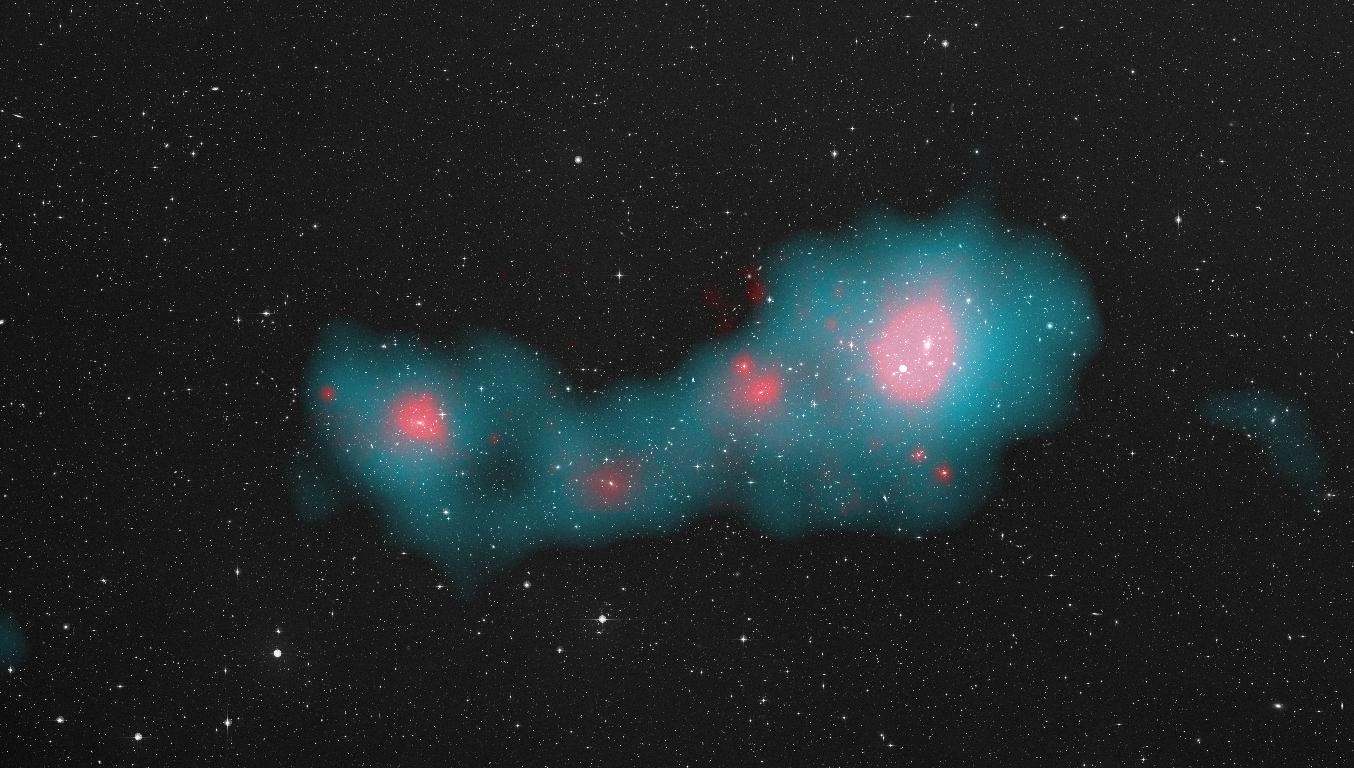Shapley supercluster: most massive structure within a billion light-years
October 22, 2013

(Credit: ESA & Planck Collaboration / Rosat/ Digitised Sky Survey)
Several hundred galaxies and the huge amounts of gas that permeate them are depicted in this view of the core of the Shapley Supercluster, the largest cosmic structure in the local Universe.
The supercluster was discovered in the 1930s by American astronomer Harlow Shapley, as a remarkable concentration of galaxies in the Centaurus constellation.
Boasting more than 8000 galaxies and with a total mass more than ten million billion times the mass of the Sun, it is the most massive structure within a distance of about a billion light-years from our Milky Way Galaxy.
The hot gas pervading galaxy clusters shines brightly in X-rays, but it is also visible at microwave wavelengths, which Planck sees as a distinctive signature in the cosmic microwave background – the afterglow of the Big Bang.
Looking for this signature – called the Sunyaev–Zel’dovich effect – Planck has already spotted more than 1000 galaxy clusters, including several superclusters and pairs of interacting clusters.
This composite image of the core of the Shapley Supercluster combines the gas detected with Planck at large scales between the members of the supercluster (shown in blue) with that detected in X-rays within the galaxy clusters of Shapley using the Rosat satellite (pink), as well as a view of its rich population of galaxies as observed at visible wavelengths in the Digitised Sky Survey.
The largest pink blobs of X-rays identify the two galaxy clusters Abell 3558 on the right and Abell 3562 on the left, as well as a couple of smaller groups between them.
The image measures 3.2 x 1.8 square degrees and shows the central portion of the Shapley Supercluster. It was produced by reconstructing the Sunyaev–Zel’dovich effect from the Planck frequency maps, and was first published in a Planck Collaboration paper in March 2013.
According to Universe Today, Planck released a cosmic map in March refining the Universe’s age to 13.82 billion years. Planck will run out of fuel on Oct.23 and will be in parking orbit around the Sun.
Abstract of arXiv paper
We describe the all-sky Planck catalogue of clusters and cluster candidates derived from Sunyaev–Zeldovich (SZ) effect detections using the first 15.5 months of Planck satellite observations. The catalogue contains 1227 entries, making it over six times the size of the Planck Early SZ (ESZ) sample and the largest SZ-selected catalogue to date. It contains 861 confirmed clusters, of which 178 have been confirmed as clusters, mostly through follow-up observations, and a further 683 are previously-known clusters. The remaining 366 have the status of cluster candidates, and we divide them into three classes according to the quality of evidence that they are likely to be true clusters. The Planck SZ catalogue is the deepest all-sky cluster catalogue, with redshifts up to about one, and spans the broadest cluster mass range from (0.1 to 1.6) 10^{15}Msun. Confirmation of cluster candidates through comparison with existing surveys or cluster catalogues is extensively described, as is the statistical characterization of the catalogue in terms of completeness and statistical reliability. The outputs of the validation process are provided as additional information. This gives, in particular, an ensemble of 813 cluster redshifts, and for all these Planck clusters we also include a mass estimated from a newly-proposed SZ-mass proxy. A refined measure of the SZ Compton parameter for the clusters with X-ray counter-parts is provided, as is an X-ray flux for all the Planck clusters not previously detected in X-ray surveys.
(¯`*• Global Source and/or more resources at http://goo.gl/zvSV7 │ www.Future-Observatory.blogspot.com and on LinkeIn Group's "Becoming Aware of the Futures" at http://goo.gl/8qKBbK │ @SciCzar │ Point of Contact: www.linkedin.com/in/AndresAgostini
 Washington
Washington